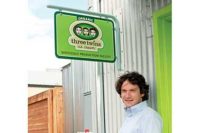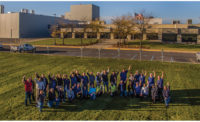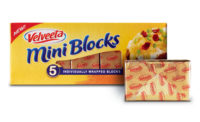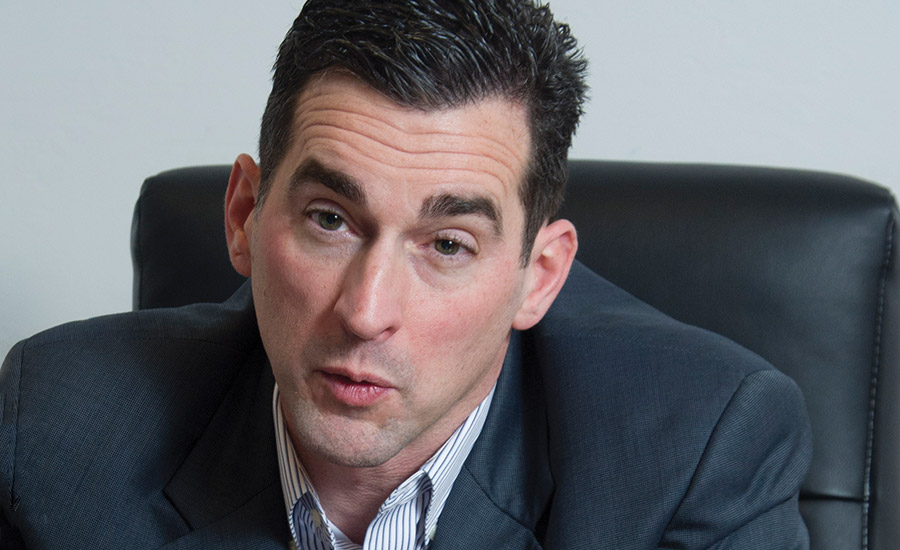Arla Foods aims for the cheese aisle
Havarti, Gouda and Edam are cheese types from the Old World. But Arla is making them in Wisconsin. The CEO of the U.S. division of this European dairy co-op talks about Arla’s growth strategy here and its Cheddar cheese joint venture with Dairy Farmers of America.

Arla Foods CEO Don Stohrer Jr. says the company’s vision is to build Arla as a “power brand” in the dairy aisle and establish Castello as “a leader of innovation” in the deli aisle.

CEO Don Stohrer Jr. (seated, left) joins his colleagues at the cheesemaking facility in Hollandtown, Wis. Also seated are Per Mogren Christiansen, site director; and Rene Arndal, administration manager. Standing (from left): Jason Mathis, PTD manager; Paul Davies, packaging manager; Matt Dempewolf, logistics & planning manager; Mark Hinderman, production manager; Rob Hungerford, health/safety senior engineer; Duane Petersen, master cheesemaker; Julaine Kluever, HR manager; and Bruce Kobussen, field manager.

The package design promotes the brand, product attributes and the cheese itself. The reverse side tells the story of the company’s roots, core beliefs and values.



The European dairy cooperative Arla Foods amba has set its sights on the United States. The strategic plan of this co-op based in Denmark states that the goal is to “excel in eight dairy categories; focus on six geographical regions and win as one united and efficient Arla.”
By 2020, the co-op sees 50% of its growth coming from outside Europe. We spoke with the head of Arla’s U.S. operation about the role he plays in achieving this goal.
But first: Who is Arla? It is the world’s fourth largest dairy cooperative and seventh largest dairy business, according to Rabobank’s 2016 Global Dairy Top 20. The Dutch bank has Nestle, Lactalis and Danone at the top of its list, followed by the dairy co-ops Dairy Farmers of America, Fonterra, Friesland/Campina and Arla, with 2015 sales of 10.3 billion euro (about $10.8 billion).
In North America, Arla Foods Inc. ranks No. 62 on the Dairy 100, this magazine’s annual list of the largest dairy processors in Canada, the United States and Mexico. Arla reported sales of $362 million in 2015.
At the heart of the growth strategy is Arla’s 110,000-square-foot cheesemaking facility in Hollandtown, Wis., near Green Bay. (See related article)That’s where we caught up with Arla Foods Inc. CEO and President Don Stohrer Jr.
The headquarters of the U.S. division is in Basking Ridge, N.J., but Stohrer visits the plant regularly to update the 225 employees there on the company’s progress. Stohrer talked with Dairy Foods editor Jim Carper about Arla’s goals in the United States. Following is an edited transcript.
Dairy Foods: How does Arla’s U.S. division fit into the parent company’s overall strategy?
Don Stohrer Jr.: Arla’s global corporate vision is to create the future of dairy by bringing health and inspiration to the world, naturally. And you really need to be prominent in the U.S. to fulfill that vision. You can’t be a true global player without being prominent in the U.S. Another critical part of the global strategy is building our brands, Arla, Castello, Lurpak, which makes the U.S. critical to achieving long term goals given how this is a market driven by brands.
To play a key role in the global strategy, we needed to evolve our business in the U.S. 95% of our sales up until a year and a half ago were done in the deli area. 92% of the volume of cheese in the U.S. market is sold in the dairy. So in the U.S., we were upside down regarding where the bulk of the business was done. Starting back in 2014, we began acting more strategically commercial in the U.S., focusing on building brands based on key market insights, and we started making gains on our brands and momentum with key customers.
Our corporate parent started to recognize that. As we acted more in line with the way the trade and the channels operate here, we started gaining traction. The company basically said, “You’re proving to us that it’s a viable market for us.” And now we’re ready to invest here in support of the global vision.
Dairy Foods: Here in the U.S., are you selling both the cream cheese (which is imported from Europe) and the (domestically produced) Havartis and the Goudas? Or are you concentrating on the Havarti?
Stohrer: It’s broken down really between the dairy aisle and the specialty deli aisle for us, as opposed to by cheese type or product type. In the deli section, we have the Castello brand focused on a growing range of unique specialty cheeses, like our imported Danish Havarti and imported Danish blue cheese. And we’ve also launched an imported award-winning U.K. Cheddar from Taw Valley, and the range will continue to expand in the near future.
In the dairy aisle, we launched the Arla brand, featuring (Wisconsin-made) Havarti, Gouda, Muenster and Fontina in slice format and snack format. In addition, we have Cheddar that will be coming out of our joint venture with DFA at the end of 2017. And then [there is] our imported cream cheese. What makes Arla products unique to the dairy aisle is the combination of being clean label and delivering on great taste. The consumer has in the past thought these were mutually exclusive, that you must sacrifice taste for better-for-you attributes. We’re in the process of changing that notion.
The vision is that we build [Arla] as a power brand in the dairy aisle and we establish Castello as a leader of innovation in the deli aisle.
Dairy Foods: It sounds like you’re stronger in the deli well than in the cheese aisle.
Stohrer: No, it’s probably pretty even. The bigger part of the growth aspiration is in the dairy aisle, purely based on the size of the segment. The deli section has been growing anywhere from 4% to 10% or 12%, based on “foodie” consumers being open to new flavors and cheeses. And we’ve been outpacing that trend with our Castello brand.
The dairy aisle as a whole has been, at best, flat. I’m talking volume and not dollars, so it’s not price-increase affected. So we see a big opportunity to bring growth to a dairy aisle, which has been quiet for a while, with our clean label, great tasting Arla branded products.
Dairy Foods: When you’re talking to a dairy buyer, what’s your pitch to get into that dairy case?
Stohrer: The first thing is talking about who Arla is. The fact that we’re owned by 14,000 farmers is truly farm-to-table, it’s unique to what’s in the dairy aisle today. We’re about being responsible, environmentally friendly, sustainable, and doing things the right way. It’s at our core as an organization. Every retailer recognizes the consumer is looking for that, as today’s consumer wants to know more and more about the products they’re feeding their families. 75% of our target consumer is reading ingredient statements, checking to see what’s in the products they’re serving their families. It’s really a completely different world than ten years ago. And they have more access to that type of information than ever. That aligns really well with Arla’s transparency and who we are as a cooperative.
We’ve always done it the right way. We control the supply chain, we can trace everything. We’re not just a brand; we are the producer and the manufacturer.
That’s how it would start. Then we go into the really promising performance of the Arla brand in the dairy aisle from this past year. We ended the year in about 6,000 stores in cream cheese. We’re in about 2,600 stores in our dairy aisle with cheese slices, and the momentum on the velocity of our dairy items indicates the consumer is picking it up…and coming back.
In-market retail data shows our Havarti and Gouda slices are in the top 20 for unit sales, and nearly a third of our cream cheese sales is incremental to the category. For a burgeoning brand in the world’s largest consumer market, that’s an accomplishment. When we launched Arla cream cheese and promoted it through social media, we had an 80% increase in calls to the consumer call center. It wasn’t people saying, “I need a coupon.” It was people saying, “Where can I find it?”
Dairy Foods: Is the fact that Arla is a European brand add any cachet?
Stohrer: No. It’s really building the brand around those product attributes. It’s not necessarily about the origin, because the U.S. portfolio isn’t totally European. 60% of what we sell right now is made here. It’s more about being that trusted advocate for the mom who’s looking for that combination of taste and better-for-you, from a source she can trust.
In specialty cheese, [Consumers] like to hear some about the origin and some of the authenticity, because there is a story and cachet. When you’re at home entertaining with the cheeseboard, you want to explain to everybody the story behind each cheese. It brings the romance, the authenticity. Castello products have that. In the dairy aisle, it’s much more everyday consumption and family-oriented, and about the taste and better-for-you attributes.
Dairy Foods: How does the packaging tell the Arla message and support the product?
Stohrer: Every component of the Arla brand packaging from a hierarchy standpoint had a reason behind it. Consumers, when they’re shopping in the dairy aisle, want to see the cheese type prominently displayed, as it helps them navigate the shelf easier. And we designed our packaging to support that. Our brand-blocking in the hierarchy also helps the navigation, so they can find Arla.
We have the logo lockup, which is what we call the green skyline and the Arla logo. (See image on page 58.) What’s also really critical is the speech bubble on all our dairy products. It promotes and communicates clearly the proprietary product attributes, no artificial hormones, no artificial preservatives or flavors. The beauty shot and the speech bubble are the No. 1 and No. 2 things that a consumer prefers on the pack, as we know it’s that combination that’s most important: taste plus better for you.
On the back is the Arla story, talking about our roots, core beliefs and values, the fact that we’re a co-op owned by 14,000 farmers, that we take environmental sustainability, traceability, and animal welfare to heart. It’s in the DNA of who Arla is, which really separates us from everything else that’s in the dairy aisle.
Dairy Foods: What does it take now to grow this brand?
Stohrer: It takes a few things. One of the big focuses we had this year was building out the commercial organization, specifically in the sales area. The U.S. sales force has tripled in size. It was not only increasing our coverage but increasing our quality. When you’re dealing with dairy buyers, you’re dealing with a more center-of-store FMCG (fast-moving consumer goods) or CPG (consumer packaged goods) mindset.
The company came up through that distributor area in the deli. With the new team, we are going to bring those competencies to the deli aisle, and while also making the push into dairy. We needed to make sure we have the right kind of profile in the sales force to grow both the Arla and Castello brands in the U.S.
Then we have to make sure the brand value proposition is presented, to both customer and consumer. We’re trying to bring some freshness, some newness and also some things that are unique to the category, that fills unmet needs and help the customer succeed. We knew going in there was a gap in the category, that the consumer was looking for cheese and cream cheese that delivered equally on taste and better-for-you. And the Arla brand fills that gap. There’s a big demand for what we’re offering, and the numbers are speaking for themselves. It’s all about expanding beyond the base we’ve established in 2016 distribution-wise.
Come April of this year, we’ll have a big campaign kickoff in support of the Arla brand nationally, basically a $30 million media investment that will feature TV, print, out of home, in-store and shopper marketing. The company has really pivoted towards the U.S.
Dairy Foods: You’ve been making cheese here since 2006 and now you have this big push to expand the brand. Are you making more cheese now, or just getting better at selling it?
Stohrer: We’re getting more efficient. We’re looking to get more production out of the existing situation. We’re also reallocating our portfolio mix. There is some increase in efficiency, which will allow us to produce more.
Dairy Foods: One of the big trends in food is snacking. How does Arla address this with its formats and packaging?
Stohrer: 97% of consumers snack once a day, and one in two snack more than three times a day. Cheese is the No. 3 item that consumers prefer for a snack. Why? It’s better-for-you snacking. You get protein, calcium and the vitamins and inherent attributes that cheese brings to the table, no pun intended.
We are launching Arla retail snack packs in grocery stores this year with the same proprietary benefits as our slices, in Gouda, Havarti, and soon Cheddar. Our snacks are currently distributed at Sam’s Club nationwide, and also launching at major grocery chains in first half of 2017. Essentially, our value proposition is aligning with that snacking trend. And the consumer is looking for that combination of clean-label attributes and great taste in snack occasions for her family.
Dairy Foods: Tell me about the joint venture with DFA and the products that you’re going to make when the factory comes online.
Stohrer: What comes out of the DFA-Arla partnership will be Cheddar in slices, snacks and eventually shreds. We need a critical-mass cheese type from a Cheddar standpoint that is hormone-free, which currently doesn’t exist in the market from an established brand. DFA brings a high level of competency, sophistication and production capability to the partnership, and we’re thrilled to be partnering with them.
The joint venture in western New York broke ground in August of 2016. It will be completed by the end of 2017 and will be shipping product from that joint venture Q1 of 2018.
It’s really a good alignment from a partnership standpoint. [Arla and DFA are] both farmer-owned. We both have the same core values and adhere to strict farming principles that make sure that the way we’re bringing products to the marketplace is the right way.
Looking for a reprint of this article?
From high-res PDFs to custom plaques, order your copy today!











